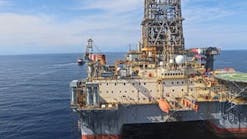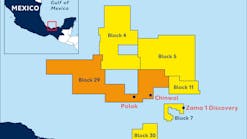Jeremy Beckman
Editor, Europe
Early in 2006, Mauritania should join the league of African deepwater producers. The 120-MMbbl Chinguetti development is well under way, and three more positive finds have resulted from only a small number of deepwater wells.
Assessment of the various deep and ultra-deepwater play types is still in the early stages. However, a broader picture should emerge over the next six to 12 months, with two drillships booked by Woodside on behalf of the various block partners for six exploratory wells and up to four appraisal wells on the Tiof discovery. One of the wells will be operated by UK independent Dana Petroleum, which holds three large production-sharing concessions (PSCs) covering a total area of 34,500 sq km.
Dana's first operated well on this acreage, on block 7, led to discovery last year of a gas field named Pelican. Woodside Petroleum recently exercised an earn-in option to this block; other Australian companies Hardman and Roc Oil hold the balance, and these two are also Dana's partners in block 1, along with Energy Africa, and in block 8, where Wintershall is the other co-venturer.
On securing the blocks in 2000, Dana moved quickly to commission 6,000 line km of 2D seismic, using the Veritas DGC vessel New Venture. This program was designed to better delineate leads from previous studies. Early analysis indicated the presence of an extensive fan system in blocks 7 and 8, analogous to others elsewhere in West Africa containing proven giant fields. In block 1, there appeared to be numerous structures that had been generated both by salt movement and faulting.
Following a further 2D survey, PGS' Ramform Victory was engaged in late 2002 to acquire a 1,330-sq-km of 3D survey in block 1, with a view to evaluating and finalizing drilling targets. The brightest prospects identified, named Faucon and Petrel, were mapped with combined reserves potential of around 500 MMbbl. Petrel will be tested first in 2005.
null
Dana could start drilling on its Kenyan acreage in the fall of 2005.
null
Pelican analysis
Dana drilled the Pelican-1 discovery well in December 2003 using the drillship Jack Ryan, in 5,500 ft of water in the southern part of block 7. The well discovered a hydrocarbon-bearing sequence extending over 1,000 ft. On reaching its final planned depth of 12,500 ft, the well was suspended for potential future re-entry, either for deepening or a side track. Prior to suspension, comprehensive rock, fluid, and pressure data were gathered from the reservoirs intersected.
This spring, Dana issued its early technical assessment, based also on sidewall cores, electric logs, pressure measurements, and a vertical seismic profile run to look beneath the well, all integrated with an existing 3D seismic data set. There seem to be two large gas accumulations below a depth of 11,000 ft, with minimum gross thickness of 500 ft and 125 ft, with a smaller gas accumulation toward the base of the well. All three have been trapped in Cretaceous sands, representing the first significant discovery in a pre-Tertiary formation offshore Mauritania.
Reservoir fluid analysis suggests an oil-associated gas with a hydrocarbon liquid-gas ratio of 23 bbl/MMcf. Fluid composition, pressure, and structural data also point to the presence of an oil leg below the lower of the two gas accumulations. Dana estimates recoverable reserves in the range 600-800 bcf, with up to 13 MMbbl of associated liquids.
According to Dana's Chief Executive Officer Tom Cross, "Pelican-1 came in geologically very much as we had predicted in terms of the depth of the reservoir and thickness. However, the whole section being full of hydrocarbons was not foreseen. Normally, you would have expected to encounter a hydrocarbon/water contact. The fact that the three gas reservoirs all had oil shows was also encouraging.
"We believe now this may be a large, previously oil-filled structure, with gas percolating into it and pushing the oil down. That may explain the oil shows. We are re-interpreting Pelican to determine where to drill next. At the moment, however, our priority is to drill the first of our two large prospects in block 1."
The first well on the Petrel prospect should spud some time in 1Q 2005, depending on rig schedule arrangements with Woodside for the two drillships, the West Navigator and the Stena Tay.
Under its earn-in deal to block 7, Woodside acted as drilling services contractor for the Pelican-1 well, with an incentive to achieve pre-determined drilling cost reduction targets. The earliest wells in Mauritania's deepwater blocks were expensive, costing around $30 million each. This was due in part to the need to build up support services infrastructure from scratch. But Woodside has since established a base in-country to service the Chinguetti development.
The forthcoming appraisal wells on Tiof are expected to come in at under $10 million each. "The geology is now better understood," Cross explains. "We have a better idea of what to expect in terms of pressure, for example. If you look at the wells coming up, such as Dorade in block 2, you're talking about only a few days' drilling time, with the significant portion of costs coming more from mobilization and de-mobilization."
Reef structures
In block 8, Dana recently acquired a new 1,800-sq-km 3D seismic survey. This was conducted by PGS' M/V American Explorer, the main aim being to delineate drilling targets in large carbonate reefs – some up to 20 km across – identified from existing 2D seismic.
"The geology in block 8 is very different from the blocks to the south," Cross says. "We brought in Wintershall as a partner, and expect their experience in analogous areas of North Africa to benefit the joint venture."
Wintershall is the third mid-size independent to enter the frame off Mauritania, after Woodside and BG. Wintershall is considered a gas major in Europe, operating a large number of licenses offshore The Netherlands, while the other two companies are experienced LNG players. Several tcf of gas has already been discovered alongside the oil from Mauritania's four finds to date. Mauritania also happens to be the closest point in West Africa to service LNG needs on the US East Coast.
"A key feature offshore Mauritania is the repeatability of the prospects in the deepwater," Cross says. "Our acreage is equivalent to over 150 North Sea blocks, so if we can find a play, such as Pelican, that 'repeats,' this could be very important to Dana.
"The majors haven't come in yet. They believe they can do so when exploration and development enters a second or third phase. Right now, they have a lot of work to do in other parts of West Africa, but they will be prepared to carry the extra costs of entering Mauritania later on. Mauritania's government is also interested in the ultra-deepwaters to the west. That region might be interesting to those majors which have relevant experience in ultra-deepwater technology."
Kenya on same path
On the other side of Africa, offshore Kenya, Dana also holds four PSCs that are larger than its Mauritanian acreage, covering an area of nearly 45,000 sq km across a barely explored Cretaceous-Tertiary basin. These extend out from the shore to a depth of around 2,000 m. Following a study of historical geoscience data, Dana has identified seven potential play types with over 100 exploration prospects.
Last year, the company acquired 5,500 km of new 2D seismic, which has since been processed and integrated with the previous data set. A further 2D survey is now planned early next year over the most attractive prospects identified from the initial 2D. Dana also has a cost carry arrangement with farm-in partner Woodside, whereby the latter secures 40% of each PSC in exchange for carrying 80% of the costs of seismic acquisition and the first two exploration wells.
"Kenya is in a similar position to where Mauritania was three years ago," Cross points out. "We've identified some very pronounced structures on our seismic, and we are now talking with our partners Woodside and Global Petroleum about going straight to the drilling phase. Normally when you shoot 3D, you're looking to refine future drilling locations. But when the seismic shows up major structures, you may decide it is more efficient to drill early based on 2D. Under the license terms, Dana has until October 2006 to drill its first well, but that could be brought forward by a year."







